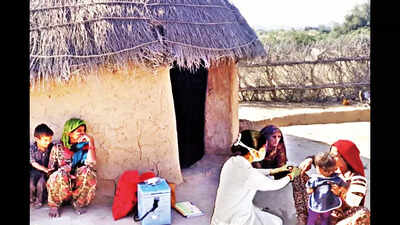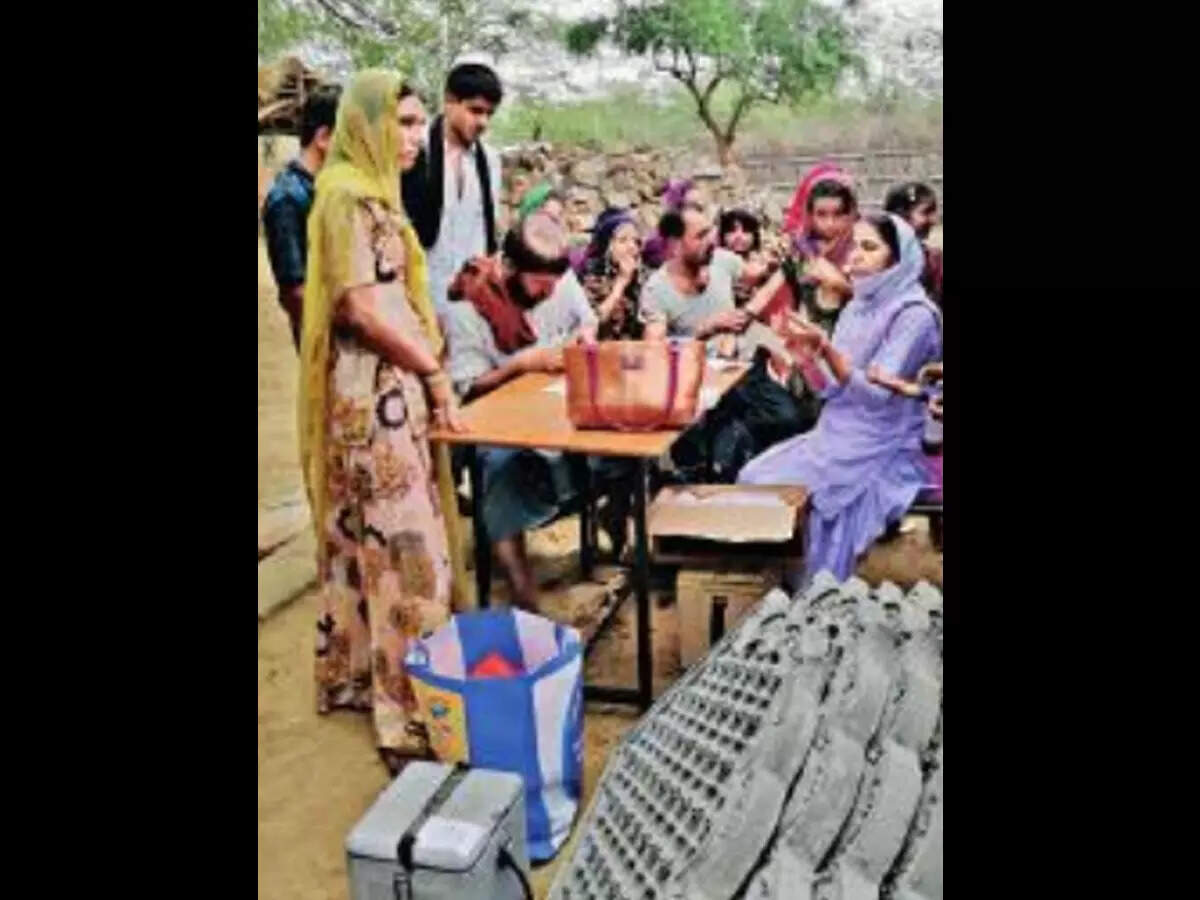- News
- City News
- jaipur News
- Covid vaccine hesitancy fades in rural, tribal belts of Rajasthan
Covid vaccine hesitancy fades in rural, tribal belts of Rajasthan

An ANM visits a house at a hamlet in Jaisalmer district for vaccinating villagers.
JAIPUR: Chotya Meena (34) of Darbheeji village in Kota was reluctant to take the Covid vaccine and avoided it in April and May. However, all his fear faded with large scale awareness by the health department, social media and newspapers. He got his first dose in July and is now awaiting to get his second dose. Now, health department is distributing 65% of its vaccines to the rural belts and 45 % is in Urban areas.
Like him several others in the rural areas of Rajasthan who were little apprehensive on taking the vaccine are seen queued up to get their jab.

Health department on Friday stated that the vaccine hesitancy has now faded away from the rural areas and even from the tribal districts like Baran, Banswara and Dungarpur.
According to an estimate by health department, in the month of July, 55 % of the vaccine distribution was at the rural areas while 45 % confined to urban area. “In this month so far we have distributed 65 % of the vaccines in the rural areas while 45% was given in the Urban areas,” said Dr Raghuraj Singh, nodal officer, vaccination.
“I think through media, social media, our awareness camps and the fear of third wave has attributed in fading away the vaccine hesitancy. All during the second wave many people lost their kin. Deadly second wave is also responsible for fading away the hesitancy,” said Dr Raghuraj Singh, nodal officer, vaccination.
Now, rural belts are vouching to get their lot of vaccines and follow up with the health department on the delivery of vaccines on daily basis.
“Some people in my village told me that with the vaccine I would be impotent. However, gradually when people of my villages too started taking the jab from June and it was found that vaccine caused no harm I too took my first dose on July 18,” said Chotya Meena, a native of Dharbheeji village in Kota.
Similarly, at the centres at Banswara, Dungarpur and Baran where locals used to confront the health authorities whenever the vaccination sites were made in their villages are now seen requesting them and motivating people to get the jab.
In April and June, the vaccination was mainly at the urban areas while rural areas were showing their resistance and hesitancy. “They now vouch for their vaccine doses. We get calls from sarpanchs and others to timely allot their vaccine is actually a good sign,” Singh added.
Authorities stated that health workers and Aasha Sehyogini workers too have worked hard in letting the fear fade away from the minds of people living in villages and hamlets.
When contacted, Sidharth Mahajan, secretary, medical and health on the changed scenario, said, “No, they ask and complain when their vaccine lot gets over. Our men in these districts are continuously following up with people engaged in vaccine distribution to know when they will get the vaccine and they ask for the quantity specifically. So, as far as Rajasthan is concern the vaccine hesitancy no longer persists.”
Like him several others in the rural areas of Rajasthan who were little apprehensive on taking the vaccine are seen queued up to get their jab.

A vaccination centre at a village
Health department on Friday stated that the vaccine hesitancy has now faded away from the rural areas and even from the tribal districts like Baran, Banswara and Dungarpur.
According to an estimate by health department, in the month of July, 55 % of the vaccine distribution was at the rural areas while 45 % confined to urban area. “In this month so far we have distributed 65 % of the vaccines in the rural areas while 45% was given in the Urban areas,” said Dr Raghuraj Singh, nodal officer, vaccination.
“I think through media, social media, our awareness camps and the fear of third wave has attributed in fading away the vaccine hesitancy. All during the second wave many people lost their kin. Deadly second wave is also responsible for fading away the hesitancy,” said Dr Raghuraj Singh, nodal officer, vaccination.
Now, rural belts are vouching to get their lot of vaccines and follow up with the health department on the delivery of vaccines on daily basis.
“Some people in my village told me that with the vaccine I would be impotent. However, gradually when people of my villages too started taking the jab from June and it was found that vaccine caused no harm I too took my first dose on July 18,” said Chotya Meena, a native of Dharbheeji village in Kota.
Similarly, at the centres at Banswara, Dungarpur and Baran where locals used to confront the health authorities whenever the vaccination sites were made in their villages are now seen requesting them and motivating people to get the jab.
In April and June, the vaccination was mainly at the urban areas while rural areas were showing their resistance and hesitancy. “They now vouch for their vaccine doses. We get calls from sarpanchs and others to timely allot their vaccine is actually a good sign,” Singh added.
Authorities stated that health workers and Aasha Sehyogini workers too have worked hard in letting the fear fade away from the minds of people living in villages and hamlets.
When contacted, Sidharth Mahajan, secretary, medical and health on the changed scenario, said, “No, they ask and complain when their vaccine lot gets over. Our men in these districts are continuously following up with people engaged in vaccine distribution to know when they will get the vaccine and they ask for the quantity specifically. So, as far as Rajasthan is concern the vaccine hesitancy no longer persists.”
FacebookTwitterLinkedinEMail
Start a Conversation
end of article
Quick Links
Delhi Air PollutionDelhi TemperatureChennai WeatherBangalore TemperatureCovid vaccination centres in DelhiCoronavirus in DelhiRTPCR test in GurgaonHyderabad RainPollution level in BangaloreDelhi SmogDelhi TemperatureNoida AQIGurgaon AQI todayFire in MumbaiMumbai RainsCovid 19 RT PCR Test in NoidaDelhi AQI todaySrinagar encounter

